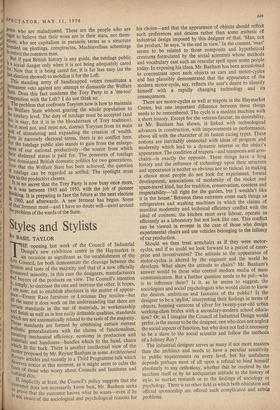Styles and Stylists
ty
BASIL TAYLOR HE opening last week of the Council of Industrial Design's new exhibition centre in the Haymarket is an occasion as significant as the establishment of the rts Council, for both demonstrate the cleavage between the Pinion and taste of the majority and that of a now officially sponsored minority, in this case the designers, manufacturers 411d buyers of the products on view. The Council's intention sitnPlY, to decrease the one and increase the other. It hopes, a am sure, not to establish absolutes in the matter of appear- ;ice—Ernest Race furniture or Lucienne Day textiles—but c" the same it does work on the understanding that there are Action) standards in the use of materials, in workmanship and finish as well as in less easily definable qualities, standards 1,7101 are not automatically related to the taste of the majority. esthetic standards are formed by combining certain current generalisations with the claims of functionalism, Ineaning mechanical efficiency. economy in production and whaterials and handiness—handles which fit the hand, chairs i.tiatter Ich fit the back. There is another intellectual view of the proposed by Mr. Reyner Banham in some Architectural deserves articles and recently in a Third Programme talk which fears notice at this moment, as it might seem to calm the etigIrtstiroalf etihitoese who worry about Councils and Institutes and cult,implicitly at least, the Council's policy suggests that the stoner does not necessarily know best, Mr. Banham seeks to Prove is Prove that the customer knows what he wants--even if he not aware of the sociological and psychological reasons for his choice—and that the appearance of objects should reflect such preferences and desires rather than some aesthetic of industrial design imposed by this designer or that. 'Man, not the product,' he says, 'is the end in view.' In the content, 'man' seems to be related to those composite and hypothetical creatures formulated by the social scientists whose methods and vocabulary cast such an oracular spell upon some people today. In exposing his ideas, Mr. Banham has been accustomed to concentrate upon such objects as cars and motor-cycles and has plausibly demonstrated that the appearance of the modern motor-cycle, say, reflects the user's desire to identify himself with a rapidly changing technology and its consequences.
There are motor-cycles as well at teapots in the Haymarket Centre, but one important difference between these things needs to be remembered. The cycle is a modern machine with a short history. Except for the veteran-fancier, its desirability, as Mr. Banham has shown, is linked with technological advances in construction, with improvements in performance, above all with the character of its fastest racing types. These notions are inevitably connected with ideas of progress and modernity which lead to a dynamic interest in the object's appearance. The condition of teapots—and teaspoons and arm- chairs—is exactly the opposite. These things have a long history and the influence of technology upon their structure and appearance is neither so obvious nor so radical. In making a choice most people do not look for experiment, formal development, associations of modernity of the rocket and space-travel kind, but for tradition, conservatism, cosiness and respectability—'all right for the garden, but I wouldn't like it in the house.' Between these extremes come such things as refrigerators and washing machines in which the claims of manifest modernity and technical efficiency conflict with the ideal of cosiness; the kitchen must save labour, operate as efficiently as a laboratory but not look like one. This conflict can be viewed in reverse in the case of those who design experimental chairs and use vehicles belonging to the infancy of car production.
Should we then treat armchairs as if they were motor- cycles, and if so could we look forward to a period of enter- prise and inventiveness? The attitude to the appearance of motor-cycles is altered by the engineer and the world he develops. What alters the attitude to chairs? Mr. Banham's answer would be those who control modern media of mass communication. But a further question needs to be put—who is to influence them? Is it, as he seems to suggest, the sociologists and social psychologists who would claim to know the desires, ambitions and fantasies of the public? Is the , designer to be a 'stylist,' interpreting their findings in terms of objects, forming canteens of silver for twenty-year-old urban working-class brides with a secondary-modern school educa- tion? Or, as I imagine the Council of Industrial Design would prefer, is the mover to be the designer, one who does not neglect the social aspects of function, but who does not feel it necessary to be a slave to the social scientist and follow the methods of a Johnny Ray?
The industrial designer serves as many if not more masters than the architect and needs to have a peculiar sensitivity to public requirements on every level, but his usefulness depends perhaps most of all upon a refusal to bind himself absolutely to any orthodoxy, whether that be inspired by the machine itself or by an antiquarian attitude to the history of style. to market research or to the findings of sociology or psychology. There is no other field in which both education and official sponsorship are offered such complicated and subtle problems.


































 Previous page
Previous page